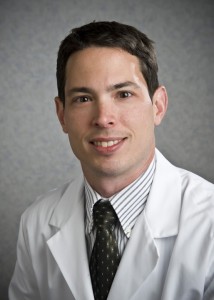
Roberto Colon, M.D., director of the Internal Medicine Residency Program and associate professor of internal medicine at the Wright State Boonshoft School of Medicine.
About 30 percent of health care costs in the United States — more than $750 billion annually — is spent on wasted care, according to the American College of Physicians (ACP).
Nationwide, physicians and medical societies are alarmed by this trend. The ACP has developed a High Value Care initiative to help physicians provide the best possible patient care, while reducing unnecessary costs to the health care system. The American Board of Internal Medicine Foundation along with Consumer Reports also has launched its own campaign, Choosing Wisely, in which medical specialty societies have developed lists of tests or procedures that are overused and evidence-based recommendations.
At the Wright State University Boonshoft School of Medicine, medical educators and practitioners like Roberto Colon, M.D., director of the Internal Medicine Residency Program and associate professor of internal medicine, are concerned about the common misperception by doctors and patients that more tests and medications are better for patients.
“Despite knowing the guidelines and most appropriate management, a recent study in the Annals of Internal Medicine showed that many physicians continue to over test for patient reassurance,” said Colon, who also sees patients through Wright State Physicians, a physician-managed multispecialty group affiliated with the Boonshoft School of Medicine. “Some of those unnecessary tests and procedures can cause patients harm.”
Colon is committed to changing physician practices by starting with medical residents.
“We realize that some of the tests we have been doing, we could do without,” he said. “We can change practices by teaching our residents correctly.”
One of the most common and costliest medical expenses is imaging for low back pain. Colon explained that most patients experiencing new onset back pain do not benefit from early imaging — X-rays, MRIs and CT scans.
“The majority, up to eight out of 10 patients, will recover within six weeks,” he said. “Having been in internal medicine practice for 12 years, I can attest that this is a problem where patient education would definitely facilitate better delivery of care.”
Taking X-rays too early may find an abnormality that will lead to additional imaging and stress for the patient. Usually, the abnormality is not life threatening, Colon said. In addition, he is concerned about repeated radiation exposure.
“The more times you are imaged, the greater the risk of cancer,” he said. “We shouldn’t randomly order X-rays.”
Initially, he recommends to his patients that they treat the low back pain with acetaminophen or ibuprofen when possible. Physical therapy, or stretching exercises, also can help patients. Colon follows up with patients experiencing low back pain in six to eight weeks, and if their back pain has not improved, he reconsiders imaging.
 Colon also warns his medical residents about the dangers of overprescribing antibiotics for sinus infections. Sinusitis results in 16 million office visits annually with antibiotics being prescribed in more than 80 percent of the cases. However, most sinus infections are caused by a viral infection and will clear up on their own, according to a study published in the Annals of Internal Medicine.
Colon also warns his medical residents about the dangers of overprescribing antibiotics for sinus infections. Sinusitis results in 16 million office visits annually with antibiotics being prescribed in more than 80 percent of the cases. However, most sinus infections are caused by a viral infection and will clear up on their own, according to a study published in the Annals of Internal Medicine.
There are some patients who might benefit from antibiotics. Those include patients with a high fever, symptoms that have lasted more than a week or symptoms that have gotten better but then worsened.
“The majority of patients with sinus infections are going to get better without antibiotics,” he said. “When we use antibiotics, we start breeding organisms, or super bugs, that become resistant to antibiotics. By reducing the amount of antibiotics we use, we may be able to reduce the development of resistant organisms.”
Colon also encourages his residents to refrain from performing pre-operative testing in low risk procedures, screening and treating asymptomatic bacteria in urine, performing routine blood work in healthy patients and prescribing a name-brand statin for initial lipid control. In the past, physicians ordered extra tests for patient reassurance, their own reassurance or the fear of malpractice suits.
“That’s a dangerous way to practice,” Colon said. “That does not lead to high value care.”
Colon tells his medical residents that good communication with patients is the key to choosing wisely. While the Internet can be a good source of information, there is a lot of bad information.
In his practice, Colon provides patients with a handout about why they may not be doing a certain test or prescribing antibiotics. He also encourages patients to view information at choosingwisely.org.
“By informing patients, we can help them better understand the decisions we make regarding their health care,” Colon said. “We should really be doing things for patients that improve their quality of life or help their disease outcome.”

 2026 Alumni Achievement Awards celebrate distinguished Wright State community members
2026 Alumni Achievement Awards celebrate distinguished Wright State community members  Bags, boards and bonding
Bags, boards and bonding  More than 1,000 students to graduate at Wright State’s fall commencement ceremonies
More than 1,000 students to graduate at Wright State’s fall commencement ceremonies  Wright State’s Take Flight Program helps students soar high
Wright State’s Take Flight Program helps students soar high  Wright State Police Department delivers major donation to Raider Food Pantry
Wright State Police Department delivers major donation to Raider Food Pantry 